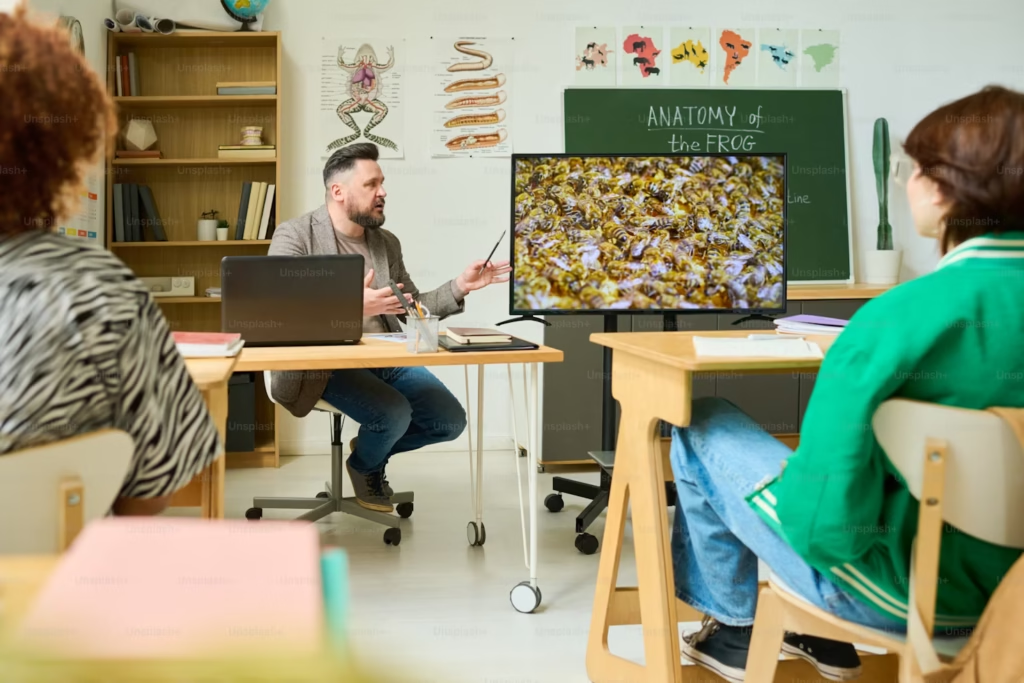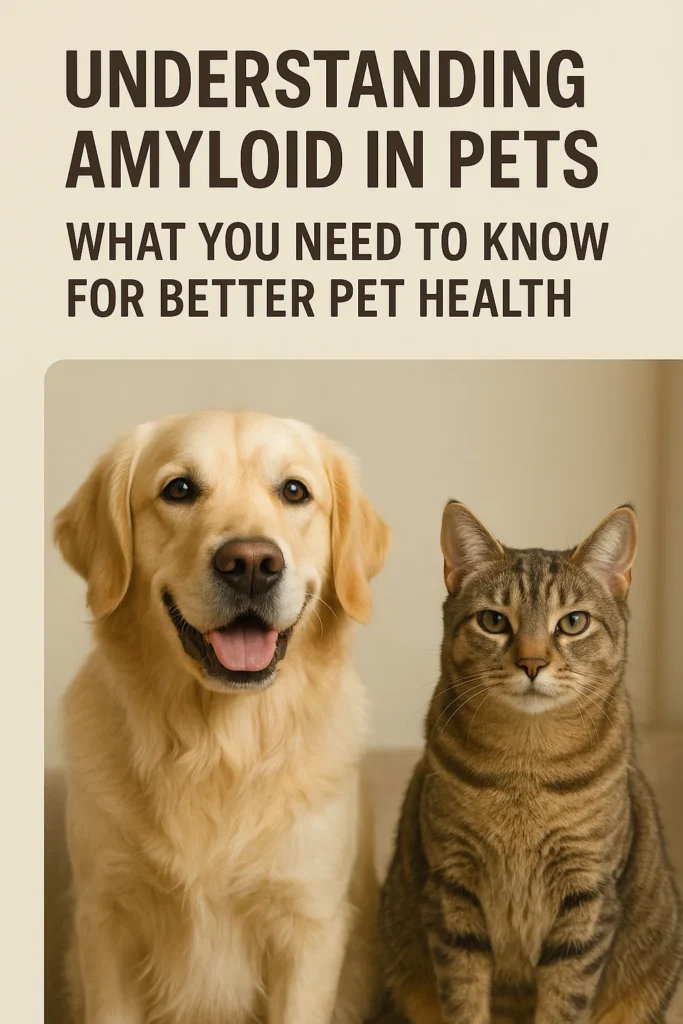A warm and engaging classroom setting where young students learn alongside a variety of small animals, such as hamsters, turtles, rabbits, or fish. These pets are housed in well-maintained enclosures placed around the room, often near windows or reading corners. The chalkboard or bulletin board might read “Classroom Pets” and display facts, care routines, and student responsibilities. Children interact gently with the animals, observing their behavior, feeding them, or recording notes as part of a science or character-building lesson. The scene promotes empathy, responsibility, curiosity, and hands-on learning in a nurturing educational environment.
Introduction
Classroom pets are often seen as just for entertainment. However, they serve a much deeper purpose. These animals are not just decoration—they help create a better learning environment. They offer more than what textbooks alone can provide.
When you think of classroom pets, you may picture a hamster or a fish. However, pets bring much more than a visual distraction. They increase participation, encourage emotional development, and teach valuable life skills. These include responsibility, empathy, and patience. Whether you’re a teacher or simply curious, this guide will show you how classroom pets can enhance education.
Benefits of Having Pets in the Classroom
Classroom pets offer several benefits that go beyond traditional learning tools. They make the classroom more dynamic and interactive. A pet is not just something to observe; it becomes part of the classroom experience. Students learn about animal biology, gain responsibility, and develop teamwork skills.
Moreover, having a pet helps students feel responsible for their learning. When they care for the pet, they become more involved and better behaved. Tasks like feeding and cleaning the pet’s cage teach time management and empathy.
Additionally, pets help reduce stress and anxiety in the classroom. In today’s busy world, pets offer a calming influence. They also encourage students to work together, improving social and emotional skills. Classroom pets teach students kindness, empathy, and compassion
Choosing the Best Classroom Pets
Choosing a classroom pet is not as simple as picking your favorite animal. The ideal pet needs to fit well with the classroom environment and be easy to maintain. It’s important to consider the amount of care and attention required to look after the pet.
The right pet should be manageable and not require constant attention. For instance, a fish is much easier to care for than a dog or guinea pig. Pets that don’t require regular cleaning or special diets might be better suited for a classroom setting.
The size of the pet is another factor. Large animals are impractical in small classrooms, while smaller pets, like guinea pigs or hamsters, are easy to keep in a cage and don’t require much space. It’s also crucial to consider the specific needs of the pet. Some animals, such as turtles or birds, need a special environment to thrive, so be prepared for the responsibility.
Classroom safety is key. Some pets may be a risk to students, especially those with allergies or phobias. Fish or reptiles can be great choices since they typically don’t need to be handled much. Always think about how the pet will interact with the students when making a decision.
Three Best Classroom Pets
There are many pets to choose from, but here are some of the most popular and suitable options for classrooms:
-
Hamsters: These small pets are fun to watch and easy to care for. Their playful behavior in a cage can be entertaining and educational for children.
-
Guinea Pigs: Slightly larger than hamsters, guinea pigs are quiet and social. They fit well in classrooms and help teach children how to care for an animal.
-
Fish: If you want a low-maintenance pet, fish are a great option. They only need basic care, like feeding and cleaning the tank. Observing fish swim can also be a calming and educational experience, especially in lessons about biology and ecosystems.
-
Turtles: Simple to maintain and peaceful, turtles offer a chance for students to learn about different species and ecosystems without too much care.
-
Birds: While they can be a bit more difficult to manage, birds provide educational opportunities about animal behavior and the responsibility of daily care.
Easy-to-Care-For Pets
If you want a pet that’s low-maintenance, consider the following:
-
Betta Fish: Betta fish are easy to care for and don’t need much space. They come in various colors and can brighten up the classroom.
-
Gerbils: Similar to hamsters, gerbils are small, low-maintenance, and fun for children to observe.
-
Reptiles (including Geckos): Geckos are fascinating to study, and with the proper setup, they don’t require much care.
Classroom Setup for Pets
The pet you choose should suit both the classroom and the students. Think about how the students will interact with the pet and how much involvement will be practical. A classroom pet setup should be simple, safe for both the pet and the students, and accessible to all.
Classroom Pet Care
Many believe that classroom pets are only for entertainment. However, they require proper care to ensure both the pet and students have a positive experience. Classroom pets aren’t just for playing; they teach responsibility and provide valuable lessons about animal care.
Looking after a classroom pet doesn’t have to be overwhelming. Establishing a routine, providing the right materials, and involving students in the process makes it manageable. This can be a great educational opportunity for children, teaching them valuable lessons in responsibility.
Preparing a Pet-Friendly Classroom
Before bringing a pet into the classroom, make sure the environment is ready. A pet-friendly classroom should be safe, comfortable, and have enough space for the pet to thrive. For example, if you have a fish tank, make sure it’s large enough for the fish to move freely and avoid high-traffic areas to reduce accidents. Similarly, guinea pigs or hamsters need large, well-ventilated cages.
The pet’s living space should be easily accessible to the students but secure enough to keep them from disturbing the pet. Place the cage or tank on a strong table or desk in a location that’s not exposed to direct sunlight. This ensures the pet can be observed while keeping them safe from stress caused by excessive noise or movement.
In addition to the pet’s enclosure, provide all necessary equipment such as bedding, food, and cleaning supplies. For example, guinea pigs need hay and fresh water, while fish require a tank filter and water conditioners. Teach students the importance of these supplies so they understand the role they play in the pet’s well-being.
Daily Care and Maintenance
Owning a classroom pet means daily care. It’s important to have a routine for feeding, cleaning, and monitoring the pet’s health. For example, with a hamster, students can take turns feeding the pet in the morning, filling its water bottle, and checking if the cage needs cleaning. A rotating schedule can help ensure that students share these responsibilities.
The most crucial aspect of daily care is keeping the pet’s habitat clean. A dirty cage or tank can affect the pet’s health and make the classroom uncomfortable. For instance, fish tanks may need a water change every week, while a guinea pig’s cage should be cleaned every few days. Regular checks are key to maintaining a healthy environment for both the pet and the students.
Involving students in the care process helps them develop personal responsibility, collaboration, and time management skills. They will feel a sense of pride in taking care of the pet, which creates ownership and responsibility. A pet in the classroom teaches students the value of regularity and consistency.
Health and Safety of the Pet
Regularly check the pet for signs of illness or distress. If you notice any changes in the pet’s behavior, such as sluggishness or loss of appetite, take immediate action. It may be necessary to consult a vet or take the animal to a clinic.
Classroom pets also need to be protected from excessive noise and rough handling. Teach students how to handle pets gently and allow them personal space when needed. This is especially important for animals like reptiles and birds, which may be more sensitive to loud sounds or too much interaction.
By ensuring the health and safety of the pet, as well as providing ongoing care and maintenance, you can create a successful and rewarding classroom experience for both students and pets.
Classroom Pet Activities for Students
The overall assumption is that pets in classrooms are only meant to give a diversion to the regular education. However, classroom pets are not just decorations in the classroom, they can be effective classroom tools. Classroom pets can be the highlight of numerous activities that can involve the students and remind them about significant pieces of information when they are employed properly.
Curriculum can be alive with the help of classroom pets and when it refers to biology, science, and even social-emotional learning. As an example, one of the class projects may be built around learning of the life cycle of the pet. 1) You will benefit in case you have a guinea pig or a hamster as the students will see how it grows, changes and learns about animal life cycle, habits and feeding as well as behavioral patterns.
One more tutoring action would be research papers when the students would study various animals and their habitat. It is a perfect idea to include the literacy part into the lesson plan, the students may do research about the origin of the pet, what this pet eats, where it lives, and how it feels in a classroom compared to the wild ones. They can even compose essays or do presentations of the findings that they have.
One more entertaining task is art projects during which the students draw or create a depiction of their pet. It can be a painting of a guinea pig or assembly of a fish tank out of recyclable materials, but it enables students to draw a creative parallel to animals and at the same time teach them resilience in care, science and animal behavior.
You may also get lessons to have classroom pets which are as subject oriented. As an example, you may provide the students with the practice of maintaining the record about the habits of the pet and compare it to the science experiment, educating students on the data gathering and data observation skills.
Emotional Skill development through pets
The presence of a classroom pet allows a child to acquire necessary emotional maturity. Many children are naturally animal lovers and they can also establish bonds that make them feel empathy and understanding with their animals. It is demonstrated that pet play can help to minimize anxiety, enhance patience and develop the social skills.
With help of the pet in the classroom, the students will have a practical learning method on the aspect of empathy. As an illustration setting up a pet will remind the students that like in case with human beings, the pet has needs that require consistent satisfaction. They will be taught the idea that the animals are dependent on their care and that every living being should be the object of attention and respect.
More than that, pets are capable of establishing trust and mutual collaboration among students. You may organize the organization of group tasks where the students, being collectively concerned about the care of the pet, make them work in groups and feel a sense of shared responsibility.
Interface with the Activation of Pets
Class pets also give a special method of attracting students to learning. There would be more chances of studying when pets are present because the students will listen and become engaged in the lessons. The pet then becomes center-stage and children eagerly come to know about the behaviors of their pets. As a case in point, in case you have a fish students may inquire on the mode through which fish breathe or the type of environment that the fish requires. The interest provokes more profound explanations regarding biology and the environment.
Use of pets in your classroom also ensures active participation. It is possible to request the students to engage in practical activities about the pet. Interactive classroom pet tasks whether in feeding the pet, diary write up or in the measuring of the pets growth makes the learning more tangible but in an enjoyable manner.
The involvement of pets in the classroom in your instructional programs will help keep the learners on their toes and hungering to be educated. Such form of learning experience can be remembered better compared to a typical lesson and it will resonate with the students even after a classroom.
Responsible Classroom Pets Management
It is not only to make the pet survive in the classroom, but also to make sure that the pet flourishes and also learn students the notion of teamwork and responsibility. Classroom pets are considered as life skill building tool and handling them should be entrusted to the students with division of responsibility as well as rotation between students so as to ensure that students develop a feeling of ownership, as well as community.
Giving Roles to Students
Among the simplest things that can be done so as to keep the pet care in the classes is by assigning students with roles. The person does not get overwhelmed and every student has a responsibility to do. As an illustration, a student may take a responsibility of feeding the pet, whereas another student is responsible to clean the cage or tank. Rothating these duties will also allow all students to practice some of their skills on pet care and will also provide them with a better insight on how to take care of an animal.
Through the roles you assign also you promote teamwork and communication amidst students. They know how to collaborate and realize that caring about an animal is a joint responsibility. This is not only an education on how to care about pets but also teaches them on how to work with others and share responsibilities. It is an excellent means of inserting the learning of the students into the pets as well as improving their social and emotional abilities.
You may also engage students in its maintenance of journal to monitor pet activities/health. This can be done by a log in which students will record the date the pet was fed, washed and changes of behavior or even health. The kids will also learn how to be observant and tracking data through the log, a very important skill in science and life.
Pet Vacation or absence plan
You can, for instance, have the alternative plan, such as a reliable teacher or another class in case of the pet care or the idea of the rotating schedule, such as with the parents of the students or the volunteers will take care of the pet during the long absence. This will not leave the pet neglected and it can still receive the appropriate care even when the students are not in class.
Paragraph 2 It is also through having a plan of dealing with these absences that kids are taught of the continuity of care. Each day, animals rely on those who take care of them and the plan will support the notion that taking care of a living being needs care, regularity and dedication, regardless of what happens in the classroom.
The Benefits of Classroom Pets for Students
Classroom pets offer far more than entertainment. They serve as instructors, teaching valuable life skills. One key lesson is responsibility. Students participate in daily activities such as feeding and cleaning, which requires follow-through. This direct involvement helps them learn to honor their commitments.
Empathy is another skill students develop. By caring for a living creature, they learn to recognize and respond to the pet’s needs. This emotional intelligence extends beyond animals, benefiting relationships with others. Younger children, in particular, gain a deeper understanding of empathy through this experience.
Patience is also developed. Pet care involves routines that must be respected. Taking care of a pet is not an instant reward but requires consistent effort over time, fostering patience in students.
Additionally, classroom pets teach cause and effect. If students neglect the pet, they witness the consequences firsthand. This reinforces the concept of accountability, a crucial life skill that applies to many aspects beyond animal care.
School-Wide Initiatives and Classroom Pet Programs
Classroom pet programs can extend beyond individual classrooms to benefit the entire school. Some schools implement school-wide pet care programs, where different classes take turns caring for a larger animal, like a rabbit. This shared responsibility fosters cooperation and teaches students to work together to ensure the pet’s well-being.
These programs also promote shared ownership, creating pride in the collective effort. When students across various grades contribute to the care of a pet, it becomes an integral part of the school culture. Such programs can help build community and encourage students to take pride in shared responsibilities.
Pets in the Curriculum
Classroom pets can be an engaging way to introduce subjects like science, biology, and animal care into the curriculum. Teachers can use the pets to demonstrate real-life applications of textbook lessons, making learning more relevant and interesting. This connection between the classroom and real-world experiences enhances student engagement and understanding.
Stress Relief and Social Development
Pets can also serve as stress relievers in the classroom. Studies show that interacting with animals reduces stress and improves mood, which helps students focus better. Pets create a calming environment, allowing students to settle into their work more easily.
Additionally, pets can aid in developing social skills. Children who struggle with communication or emotional regulation may find it easier to connect with peers through their shared care of a classroom pet. This can serve as a bridge for building social relationships.
Conclusion
Many people think that classroom pets are only for making the classroom more interesting. While it is true that pets can add excitement, they offer much more. They serve as tools for teaching valuable life lessons like responsibility, compassion, and patience. These lessons are not limited to pet care. They provide students with skills that can be used long after they leave the classroom.
Teaching Life Skills through Classroom Pets
Choosing the right pet for your classroom is about more than just creating a fun atmosphere. It gives students the opportunity to develop essential life skills. Caring for a living creature teaches responsibility and emotional intelligence. Students also learn how to manage their time and collaborate with others. These experiences help students understand animal biology, ecosystems, and even social-emotional learning.
Benefits Beyond Entertainment
Classroom pets offer more than just enjoyment. They make learning engaging and memorable. Through caring for their pet, students gain a better understanding of biology and nature. They also develop empathy, which helps in building stronger relationships with others. These lessons go beyond the classroom and last long after the students leave school.
Summary: Bringing a Pet to the Classroom
Bringing a pet into the classroom offers numerous educational and emotional benefits. It is not just about fun; it’s about creating a learning environment where students can grow. When incorporated properly, a classroom pet can foster a sense of responsibility, community, and accountability. These qualities stay with students even after the school day ends.
Next Steps: Choosing the Right Pet
Now that you know the benefits of having a classroom pet, think about which pet would best suit your classroom. Consider how it will fit into your teaching strategy. With careful planning, a classroom pet can become a valuable part of your students’ educational experience.



